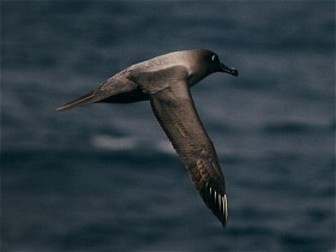Light-mantled Sooty Albatross
The Light-mantled Albatross, Phoebetria palpebrata, also known as the Grey-mantled Albatross or the Light-mantled Sooty Albatross, is a small albatross in the genus Phoebetria, which it shares with the Sooty Albatross. The Light-mantled Albatross was first described as Phoebetria palpebrata by Johann Reinhold Forster, in 1785, based on a specimen from south of the Cape of Good Hope.

Original source: Transferred from en.wikipedia
Author: Original uploader was Sabine's Sunbird at en.wikipediaPermission(Reusing this file)Released under the GNU Free Documentation License.
Permission: GNU Free Documentation License
The Light-mantled Sooty Albatross is classified as Near Threatened (NT), is close to qualifying for or is likely to qualify for a threatened category in the near future.
Grey-mantled Albatross or the Light-mantled Sooty Albatross, is a small albatross in the genus Phoebetria, which it shares with the Sooty Albatross. The Light-mantled Albatross was first described as Phoebetria palpebrata by Johann Reinhold Forster, in 1785, based on a specimen from south of the Cape of Good Hope. More
Physical description: Light-mantled sooty albatrosses have a dark grey head and a light grey body with a distinctive white crescent surrounding most of the eye. They are one of the smaller albatross in the Antarctic and subantarctic, with a wingspan of approximately 2.2 metres. Abundance - Light-mantled sooty albatross are the most abundant breeding albatrosses on Macquarie Island, where approximately 1000 pairs nest every year. More
The Light-mantled Sooty Albatross has a wider distribution, nesting on South Georgia in the Atlantic, many of the same islands in the Indian Ocean, Macquarie Island and New Zealand's sub-Antarctic islands. At sea it forages further south than the Dark-mantled to Antarctica, and around the Southern Ocean as far north as Chile, Tasmania and South Africa. At sea they often eat more fish as opposed to squid than other albatross species, and the sooties also readily take carrion and particularly other seabirds. More
The Light-mantled Sooty Albatross has not been as badly affected, and is considered near-threatened. - ABOUT ME More
Recent tracking of light-mantled sooty albatrosses breeding at Macquarie Island with miniaturised satellite transmitters, indicate that birds spent several days foraging before returning to their nests. These flights were at an average distance of 1516 km from Macquarie Island and located in Antarctic waters, mostly along the Antarctic continent. The maximum foraging range was in average 1721 km and the total distance covered by two birds for which there were complete tracks was 6463 and 6975 km. More
The Light-mantled Sooty Albatross has not been as badly affected, and is considered near-threatened. References - * Brooke, Michael (2004): Albatrosses and Petrels across the World. Oxford University Press, Oxford, New York. ISBN 0-19-850125-0 * Nunn, Gary B.; Cooper, John; Jouventin, Pierre; Robertson, Chris J. R. & Robertson Graham G. More
Incubating Light-mantled Sooty Albatross on a cliff ledge. The nest is a low mound made from mud with some plant material, and usually lined with grasses. Photographed on Enderby in the Auckland Islands, New Zealand, November 2001. Copyright of Angus Wilson. Identification - Arguably the most beautiful albatross. In flight, has a distinctive cruciform-like shape created by the combination of thin wings, long tail and long neck. More
Colour/Looks: The Light-mantled Sooty Albatross is largely sooty-brown or blackish in colour, darker on the head, with paler upperparts from the nape to the upper tail-coverts which are grey to light grey, palest on the mantle and back. The eyes are partly encircled with thin post-orbital crescents of very short white feathers. The closely related Sooty Albatross lacks the pale mantle. More
Light-mantled sooty albatross (Phoebetria palpebrata) have a dark grey/brownish head and a light grey body with a distinctive white crescent surrounding most of the eye. Nests of light-mantled sooty albatross are made from mud with some plant material, and is usually lined with grasses. It is a low mound, 15-30cm high and 45-55cm at base. Light-mantled sooty albatross are solitary nesters, although occasionally they will nest in small colonies of up to 15 nests. More
The Light-mantled Sooty Albatross has not been as badly affected, and is considered near-threatened. More
provisioning strategies of the light-mantled sooty albatross at South Georgia: competition and co-existence with sympatric pelagic predators. Marine Ecology Progress Series, 285. 259-270. doi: 10.3354/meps285259 Full text not available from this repository. Official URL: http://www.int-res.com/abstracts/meps/v285/p259-27... Abstract/Summary - Foraging and provisioning strategies of the light-mantled sooty albatross (LMSA) Phoebetria palpebrata were studied during chick-rearing at Bird Island, South Georgia, in January to May 2003. More
Light-mantled Sooty albatrosses (Phoebetria palpebrata) breed on Campbell, Auckland and the Antipodes Islands, but little is known about their numbers. They also breed on other islands around the Southern Ocean. They raise one chick every second year. Dark coloured birds with a white crescent around part of the eye and a stiff posture, they appear somewhat eerie, an impression accentuated by their haunting call. More
The Light-mantled Sooty Albatross has not been as badly affected, and is considered near-threatened. Species - Dark-mantled Sooty Albatross, Phoebetria fusca - Light-mantled Sooty Albatross, Phoebetria palpebrata http://en.wikipedia.org/wiki/Sooty_albatross The text in this page is based on the copyrighted Wikipedia article shown in above URL. It is used under the GNU Free Documentation License. You may redistribute it, verbatim or modified, providing that you comply with the terms of the GFDL. More

Original source: Yan Ropert-Coudert
Author: Yan Ropert-Coudert
Permission: Some rights reserved
Family : Diomedeidae
Genus : Phoebetria
Species : palpebrata
Authority : (Forster, 1785)

